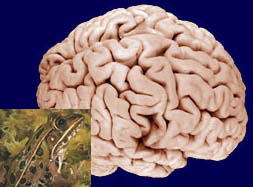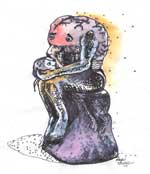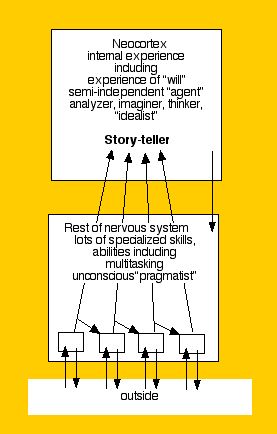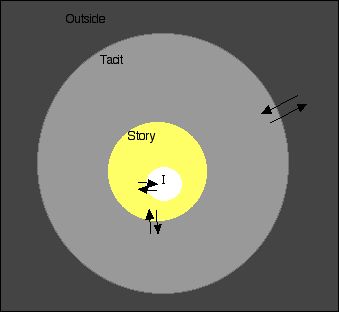Serendip is an independent site partnering with faculty at multiple colleges and universities around the world. Happy exploring!
Brain Behavior Institute - Sessions 11/13
|
|
 |
BRAIN AND BEHAVIOR INSTITUTE 2009Sessions 11, 13 |
 |
Architecture: From the Input Side
Review: a shifting perspective: loopy, semi-autonomy, semi-homeostasis, distributed, with two parts: cognitive unconscious and I-function, all patterns of activity in neurons
When we're refreshed, we can carry on with the burden ... Lucienne
I have taken numerous psychology classes where we have learned tons about the brain. But, it was never presented to me ... as a loopy process. I think it is important for teachers to stress the fact that the brain is designed to explore, instead of introducing the different parts of the brain as responsible for certain, specific actions ... Emily
if studentts have set points at which they are either set in their ways or set at a point of knowledge, we can let them learn through explorations and their "set points" are changed ... Jack
There are so many things going on in our nervous system that are preprogrammed, but the corresponding behaviors are not generated because of inhibition .... Jill
success in the academic culture comes by having a brain (architecture and training) that prizes dissonance over consonance--because out of the dissonance comes truly original ideas? And what does this mean for the effectiveness of an emergence pedagogy ...do we need more dialogue in our schools about the difference between dissonance and disrespect? ... Deb (see also Kathy, Antoinette, Brie)
We sometimes want all of our students to learn and demonstrate learning in the same way. In order to validate my student's individuality, I need to view brain differences as opportunities ... Antoinette
I liked the idea of each child building their own house ... Verolga (et al)
New principles from the input side
- Multiple inputs, unconscious/"story teller" distinction
- Brain "making things up" (see BBI05 and BBI05 with I-function help)
- Built in presumptions of "reality"
- Ambiguity as fundamental
- Conflict as fundamental
- Testing and retesting, negotiating and renegotiating - all unconscious, doesn't worry about "Truth" or "Reality", just comes up with something that works - "story"
- The "crack"
- Different for different people
- Again an unconscious/"I-function" distinction in abilities/uses
- Perception an exploratory process, testing and retesting
- Using both unconscious and I-function

- From I-function to "story teller", and story creator (making what hasn't been seen)
- "Self" as story
- Using both unconscious and I-function
- Input is always incomplete (and affected by output)
- Input is always interpreted based on prior information (including genetic information)
- Input is always ambiguous
- Interpretation is improved (but not completed) by combining multiple perspectives, resolving conflicts
- Both input and interpretation are different for different people
- What we see is a "story" reflecting unconscious processes
- "Reality" is a collective story, reflecting (desirably) the different perspecties of different people
- Stories can in turn generate new questions/observations/stories, and new stories (that in turn ...)
What particular aspect of our discussions of the sensory side of the nervous system seem most useful for your classroom, for your teaching in general? Write some thoughts/questions in the institute forum area.



Comments
What is this?
If just once while Paul was banging on the table and asking, "What is this?" his hand passed smoothly back and forth through the table----would any of us be at all surprised at this point? For me there is something really exciting about bumping up against my presumptions and discovering a whole new "playground" for the mind.
Perception Confusion
Paul, I think you are a NASA scienctist. Everything you have been discussing about how the brain works, the box in the box, and emergent learning is displayed in what the scientists at NASA are doing. Creatively, they have envisioned things and perceived things as they would be but aren't yet!
www.nasa.gov/topics/universe/features/jwst_animation.html
Look at the James Webb Telescope animation and remember that this is not in space, the model is about 2 football fields. The mind is a window to possibilities!
Seeing is Believing
Regarding the movie, Beautiful Mind, John Nash tested his perceptions many times based on the responses of his roommate to his stories. The ‘trick’ played on the movie audience was the discovery that the roommate was actually a construction of Nash’s mind. Suddenly, Nash’s story was like a house of cards falling apart as the real scenario was revealed. We could share a part of Nash’s confusion having ourselves created his story based on these imagined characters.
Interestingly, the shock that the audience felt paralleled the emotional upheaval displayed by Nash. I liked that part of the movie because the audience entered Nash’s world in a very small way but emotionally effective. The experience of being fooled as easily as Nash was quite powerful. We love to be tricked, fooled, have our emotions strung out as long as we land solidly on our feet after disembarking the ride.
I have greater empathy for those who walk among us and are not able to ‘get off’ the ride. I remember how unnerving it was to live through earthquakes knowing that there is no place you can go to escape the moving ground. I still can’t wrap my mind around the reality of the World Trade Center collapse.
I especially feel grateful each day for the ability to step on stable ground and cherish my family and friends, knowing that at any time my reality could change.
Reality Sandwich
Dear Joyce,
I too feel grateful each day for the ability to step on stable ground knowing that at any time my reality could change. Part of my reality did change a few weeks ago when my school told me I was no longer employed there. Fortunately, it was a break in my reality that was expected- a good break too. However, on a different view, I saw a mother and her child today crossing across a car-crowded street, and I was thinking how someone said just this morning that grandchildren are what makes having children worth it. But I also worry that my own grandchildren are more than likely to live within a reality that will be vastly different from mine. The world is growing so fast, the Earth is changing so fast, realities are changing fast too. But the planet is large enough and Pennsylvania is buffered enough that we will probably walk on stable ground for at least enough time from now for me to meet my grandchildren. Then, at that time (if not sooner), my reality could really change.
Bridging the Reality Gap
Jack, You've written a lovely, personal connection regarding your thoughts about the realities your Grandchildren might experience in their tomorrows. My suggestion is to continue that thought process, record your blog to me and follow with many more that describe your thinking and your analyzations of your daily reality. Address these 'thought bubbles' to you future gradchildren to allow them to see and feel your solid ground. This would be a wonderful gift indeed!
7/14 AM Session
Today there were an overwhelming amount of boxes to open and process. Many questions were answered, many were not, many were addressed, many were not. With so many boxes, that just keep opening, they can not all be answered/addressed in these sessions; especially one like today.
Equation: questions = boxes. answers = boxes.
So many boxes, so little time.
Recap: Open boxes to 'yes', not just open the 'no' boxes. Classrooms w/o walls, for me, doesnot apply to the physcial walls, as it does for most school systems. For me it means every student having a computer where they are able to access the world from their seat, encouraging them to explore and research areas of interest, as well as peaking (peeking into) areas they may find themselves interested in due to their exploration. By virtue of having the students engaged, classroom management challenges will be reduced signnificantly, allowing more time for the teacher to instruct, model, and monitor.
Being uncomfortable is a good thing, in that you are being stretched.
Computers create motivation for the students to learn, as thus the teachers to teach.
'Technology'
Fund for the best, none for the less? Promise or problem? Incentive or ???
You're overwhelmed because there are so many boxes to open.
The brain is actively throwing things away, because of the filters working in the sensory functions.
Sharp Edges: Are the edges so because we labeled them as such? God gave Adam the priviledge of naming everything (Genesis 2: 19-20).
...Sickle Cell Anemia...edges are painful...
2 dimentional: flat; 3 dimentional: binocular stereopsis
Optical illusions are not tricks. They are the the brain working.
To the "Brady Bunch theme"
Here’s a story of an inter neuron,
Who was busy shutting out the other stuff,
In the lateral inhibition network
Not working all alone.
Here’s a story, and it is changing,
And I don’t know if it will ever end,
The Open ended transactional inquiry,
Will the process continue to begin?
My growing brain,
Let me explain,
That’s the reason I joined the institute!
Paul's story <---> My story = ???
So, I have been listening to Paul's story about how the brain gets and interprets inputs, as well as how the brain constructs a lot of what we sense. While some parts make sense to me and I understand, other parts simply seem foreign, confusing, and backward. I am still grappling with that dissonance...
What I am left wondering is, What is the point? Why has Paul devoted all the time and energy (two sessions worth) to the senses? Is it simply to once again shatter my understanding of the world? To once again examine my assumptions? I already have accepted that everything I thought I knew is open for question. I have also accepted the idea that the brain constructs our reality. I'm still searching for a new understanding or a new story to emerge from these two days of work...
nervous system
The nervous system looks at things very different. Our nervous systems makes up different stories of what we see. This make me have a better understanding why my students see things different from each other.When I teach geometry , my students have different perspective on the different shapes in geometry.
point of "view" lesson
One of the most enjoyable lessons I implemented during a summer forensics program, each student had to become an eyewitnesses, I showed the students a segment of the movie “Fracture” the part where the husband shoots his wife. Afterward I asked the students to be the eyewitness and to describe in a paragraph or two exactly what happened and what the actors were wearing. The students had no idea they would be asked to be an eyewitness I did not forewarn them, just as real eyewitnesses do not know that they will be an eyewitness to a crime. After being told the task, many wanted to see it again. I told them that in real life there are no second chances to witness the same crime and to do the best they could. I do not recall a single student of the 60 or so I saw that day getting it 100% correct. Each student had his own twist based on feeling and life experience. We had such a great time reconstructing what we saw and “freeing” it up from each individual’s mind. As the story grew, some students changed their mind and their stories. We began to realize that many of us had constructed what was real to us and we even filled in what was missing in our mind. We laughed and carried on; we ended the lesson by viewing the scene again to find our mistaken view points. Many of the students were surprised in the assumptions they made and how incorrect they could be. We could all use an exercise like this to show how no one is completely right or wrong and how our brain can/will change a story to fit our experiences or view points.
Burning question
Are there people whose brains do not construct a complete picture of the outside world, or are there people who are able to detect the area in the eye where the optic nerve exits the eye???
Missing the Institute
Good morning to all from Goddard Space Center. I enjoyed reading this morning's comments because it really applies to what we are doing here at Goddard. The scientists are making up things(they are trying to analyse the outer galaxies in our life time as well as age the universe), as they see them in their brains. They are trying to make sense and convey their reality to other people and then try to make it real to them! They sometimes go through sign language changes because they are trying to teach someone else what they invision in their mind as a reality that can work in space. The mind is an interesting thing to explore. I feel like the student whose mind is starting to emerge.
Miss you
Hey Judy, sounds like your training is very productive. Keep that movie camera in your head running and play some 'clips' for us when you return!
You can see with your tongue
Wow! I was good with the idea that we had more than five senses and that none of them were tied to physical input organs....but I just finished reading Can You See With Your Tongue? Wow!
7/13 AM Session (Edited)
As I become more interested in the brain as it relates to rest and sleep, I wonder if the brain processes rest and sleep as input. I've learned that when we 'sleep' our brain continues to process all the 'inputs' it has received, now having a time to 'catch up'. So...does our brain ever sleep, or is it processing the input that the body is sleeping?
The Eye!
The discussion this morning brings an entire new meaning to the common phrases: “There is more than meets the eye!”, “I spy something……..”, “Do you see what I see?” and “Here looking at you, babe!” In other words, the eye is an incredible symphony in constant motion.
Synesthesia
When I was in the Philippines, my friend and I attended an Easter Celebration in a Province where neither of us lived. Serving there in the Peace Corps as a Deaf Education Instructor, Joan immediately took interest in a young girl, about 8 years old, who was happily moving through the crowd in a very animated fashion. She watched her for some time and then went over to you and found as she suspected, that the child was deaf. In a third world country we understood that those who are handicapped in some way are given at least some of what the need by performing some service to the community. Much to our chagrin, it was often to entertain, (court jesters so to speak). The little girl was very sweet and we spent some time with her that day. Joan was conducting her own little research study and concluded at the end of the day that the deaf child was actually using sign language very close to ASL - but obviously constructed by the girl. We were fascinated about how this came to be since only the very rich (3% of the population) had access to formal deaf education.
Today’s session on synesthesia brought about a new understanding of the phenomena. Her sign language arose from a function of perhaps common human brain strategies that allow us to find ways to communicate with each other.
Memory and the "story teller"
When I think of how I memorize/ learn names, I often use mnemonic devises, which are entirely arbitrary. In order to remember the Emily’s cute little black and white dog, Domino, I think not of his color, but of “Get the Door, its Dominoes’, an advertisement for pizza. It is not right or wrong, but it helps me to remember the dog’s name. I also used to have neighbors named Michael and Janet, whose names I had a difficult time remembering, until I thought of them as “the Jacksons”, after that I had no difficulty remembering their names.
Memory as "the story teller" allows me to construct, build, or make up, information in a meaningful way to me.
Link for constructedness of ... and
Link for constructedness of senses/synesthesia
Link for illusions and ...
Post new comment